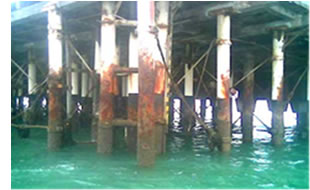

Webmaster: Stansfeld, LLC. |
|
|

MARCH 2015 MEETING
Wednesday, March 11, 2015 (1.0 PDH)
TECHNICAL PROGRAM
150 years of Advances in Civil Engineering Construction Materials from Conventional Concrete to Innovative FRP Composites
Speaker: Abdeldjelil "DJ" Belarbi, Ph.D.,P.E.; Hugh Roy and Lillie Cranz Cullen Professor. Tel No. (713) 743-1609.
Dr. Abdeldjelil Belarbi is Hugh Roy and Lillie Cranz Cullen Professor of Civil Engineering. He is actively engaged in a broad spectrum of structural engineering research areas, with primary contribution in the constitutive modeling, analytical and experimental investigation of reinforced and prestressed concrete structures. His research has also focused on seismic and wind structural performance of building envelopes, as well as smart structures and use of FRP composites with focus on the development of advanced materials and use of FRP for rehabilitation and strengthening of aging and deteriorated civil engineering infrastructure.
Dr. Belarbi has served as principal investigator or co-investigator on numerous research projects with a research expenditure of over ten millions US dollars, has published over 200 technical papers and had supervised over 45 MSCE theses and PhD dissertations. Dr. Belarbi is the recipient of numerous awards and honors. He is a Fellow of both the American Society of Civil Engineers (ASCE) and the American Concrete Institute (ACI). He is also very active (member and/or Chair) on several technical and educational and national committees within ACI, ASCE, ASTM, and TRB.
 PRESENTATION SUMMARY
PRESENTATION SUMMARY
As an introduction to this topic Dr. Belarbi began with a short review of 150 years of Advances in Civil Engineering Construction Materials, from Conventional Concrete to Innovative FRP Composites. In this discussion, a saying was presented with regard to development of new2 materials and processes, “Look at the past, learn from successes and failures, and prepare for the future”.
Historical facts regarding construction materials and processes were addressed:
Bldg materials – Historically, construction materials used was determined by availability and climate, typically stone and wood.
Development of types and growth of structures over time - use of various materials and construction practices was illustrated, referencing pyramids, aqueducts, coliseums, etc.
Development of “Building Codes” – the first was the “Code of Hammurabi”
Major developments in materials and construction methods –
Rocks and stone, - arches, use of compressive strength
Columns with flat short spans, i.e. Stonehenge
Reinforced concrete – long spans, columns; Portland cement concrete, conventionally reinforced concrete vs pre-stressed concrete, high performance reinforced concrete, fiber reinforced plastics – stronger, lighter, durableTime of development from concrete to reinforced concrete to pre-stressed concrete, to FRP
Development of technology – “The idea, the fantasy, the fairy tale, reality”
Most buildings built about 1950 – nearing the end of their expected life, what to do – tear down? Not economically feasible? New construction? Old structures now required to service ever increasing loads and cycles of use. Examples -
Bridges built for light traffic and loads must now support much heavier concentrations of traffic and extreme loads
Changing traffic demands, Improvement in design, Long-term deterioration, Man-made structural damage
Current challenges - World infrastructure Investment needs 2013-2030, Costs needed to replace or repair deficient structures is severe with many at the end of their expected lives
Addressing problem, experience and foresight – material suggestions “Traditional to FRP”
Fiber Reinforced Polymers (FRPs), as advanced composite materials manifest their presence in the civil engineering construction market in an increasing pace with their superior material properties compared to conventional construction materials. Their lightweight, high tensile strength, resistance to corrosion and easy formability and handling make them a noteworthy alternative to other materials. This presentation will provide an overview of what we have achieved using Portland cement and conventional concrete, introduction of plastics as new construction material, and challenges ahead of us to not only refine our design standards, but also look for ways to keep our aging infrastructure alive and built new sustainable and resilient structures.
FRP – Aramid carbon or fiberglass reinforced – fibers or fabric matrix – light weight, high strength, corrosion resistant, flexible applications - Linear elastic, no yielding, higher ultimate strength, lower strain at failure
FRP 3-4 times stronger than steel, limitations – cost, anisotropy, brittle, etc
No corrosion but some environmental concerns regarding durability – temperature, moisture, etc.
Uses, bridge decks, Abutment panels, aircraft, auto’s, sports equipment, spacecraft, etc
FRP strengthening – Flexuural, axial, etc methods – steel plate bolted to concrete, member enlargement, FRP sheet – extra steel and concrete increases weight, FRP very light for essentially the same results, with installation time and complexity much less for FRP – by hand in one day – similar to painting, saturate FRP sheet with epoxy, apply to clean surface (certified applicator), roll out as for paint.
Application methods discussed. Applicators must be trained and certified and mfg’s specifications must be carefully followed. Showed various examples of applications.
Flexural strengthening of beams, apply to sides, top and bottom. – brittle so adding layers of FRP increases strength but reduces ductility (flexure).
Environmental reduction factors - .95 to .5 depending on CFRP (.95 -.85, AFRP,(.85 -.7) or GFRP (.75 - .5) Interior/exterior/aggressive conditions
Shear strengthening limited experimental knowledge base, limited testing/investigation, NCHRP Report 678, 2009-10 , on-going research, analytical models and design codes, Safety factors are arbitrary at this time.
Limitations on use because of possible types of failure and their impact on a structure, National Science Foundation projects. National Cooperative Highway Research Project “ASHTO” Code.
|



